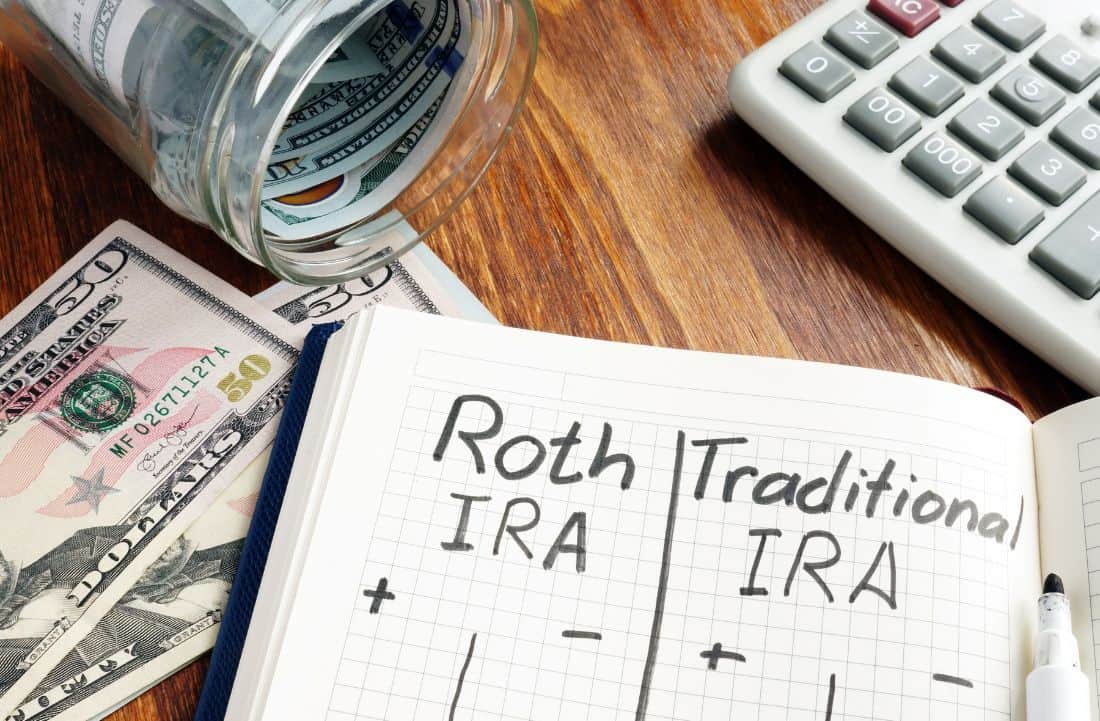Traditional or Roth IRA: Which is Right for Me?
February 27, 2023

Time is your best friend when it comes to saving for retirement. Ideally, you’ll start putting money into retirement accounts in your early 20’s. The reason is two-fold: 1) it allows ample time for your money to grow and compound over the years, and 2) it’ll provide the greatest tax benefits – a component of retirement planning people tend to overlook.
Many tax-advantaged retirement accounts limit how much you can contribute per year. To maximize your tax savings, you’ll want to start early. One such account that everyone should consider is an IRA.
What is an IRA?
An individual retirement account (IRA) is a tax-advantaged investment account designed to help you save for retirement. There are various IRAs, the most popular being Traditional and Roth IRAs.
Before deciding which type of IRA will work best for you, it’s helpful to understand the main features of these specialized accounts.
- Tax-Savings: IRAs allow you to experience tax benefits either in the current year or upon retirement.
- Individual Accounts: As the name implies, IRAs are individual accounts. Unlike Health Savings Accounts (HSAs), where spouses can form a family plan, each spouse will need their own IRA to benefit fully.
- Contribution Limits: There are restrictions on how much you can contribute to your IRA per calendar year. For example, in 2023, individuals may contribute up to a maximum of $6,500 in a Traditional or Roth IRA ($7,500 annually if you’re over the age of 50).1
- Delayed Withdrawals: You may begin withdrawing funds from your IRA once you reach the age of 59 ½ years.
- Investment Options: You have the option to use a retirement brokerage account, which allows you to invest within the markets. Or you can choose an IRA at a financial institution, such as the credit union or a bank. The latter two provide more conservative options that benefit those just starting out or individuals who are nearing retirement.
- Types of IRAs: There are four types of IRAs – Traditional, Roth, SEP, and SIMPLE. Traditional and Roth IRAs are the most popular. SEP and SIMPLE IRAs are geared more toward self-employed individuals or small businesses that lack other employee retirement plans.
- Workers in their peak earning years. If you’re at the climax of your career earning potential, you’re most likely in a higher tax bracket today than you will be once you retire. In this scenario, tax savings today will likely outweigh those in your retirement years.
Choosing Between a Traditional and Roth IRA:
Deciding which IRA is right for you isn’t always clear-cut. Both options help you save for retirement, and each has its own set of unique perks. The greatest differentiator between the two is how the tax benefits come into play.
Once you understand how each IRA can impact your current or future taxes, choosing the option that best aligns with your future goals and your outlook toward retirement becomes easier.
Traditional IRAs:
A traditional IRA allows you to save on taxes now. It’s similar to most employer-sponsored 401(k) plans.
Common features include:
- Contributions: The money you contribute to your traditional IRA is pre-tax, meaning you don’t pay taxes on the funds in the current year. Typically, contributions are withdrawn automatically from your paycheck and are transferred directly to your IRA.
- Tax Deductible: The tax perk of traditional IRAs is that the money deposited in the current year is generally tax deductible. You’ll pay fewer taxes for that calendar year by reducing your taxable income.
- Grows Tax-Deferred: The money in your traditional IRA will grow tax-deferred, meaning you don’t pay any taxes on the money you earn until you begin making withdrawals.
- Taxes Due: With a traditional IRA, you pay taxes on the money once you make withdrawals in retirement. The amount of taxes you pay will be dependent upon current tax rates and your qualifying tax bracket.
- Early Withdrawals: Accessing the money in a traditional IRA prior to age 59 ½ will result in penalties and being required to pay taxes on the withdrawn funds.
Ideal Candidates for a Traditional IRA:
- Individuals looking for immediate tax savings. A traditional IRA instantly lowers your current-year tax bill through tax-deductible contributions.
Roth IRAs:
A Roth IRA provides tax benefits in retirement.
Common features include:
- Contributions: The money you contribute to your Roth IRA is made after tax, meaning you pay taxes on the funds in the current year.
- Grows Tax-Free: The money in your traditional IRA will grow tax-free. You will not pay taxes on any money you earn in a Roth IRA over the years.
- Tax-Free Withdrawals: Since you already paid taxes on the money in your Roth IRA when you made your contributions, you do not pay taxes on these funds again. Instead, you will enjoy tax-free withdrawals on all the funds in your Roth IRA once you retire. It’s this perk that makes Roth IRAs so popular and beneficial.
- Early Withdrawals: Unlike a traditional IRA, you can make early withdrawals from your Roth IRA without penalties or being required to pay taxes. However, this only applies to your contributions – not money earned in the account. If you withdraw earnings, you could be subject to early withdrawal penalties and potential taxes.
Ideal Candidates for a Roth IRA:
- Younger to mid-level workers who have yet to reach their peak earning years.
- Individuals who anticipate being in a higher tax bracket once retired.
- People who believe taxes will be higher in the future. For example, the US debt level continues to rise, and most will agree that taxes will have to increase at some point to repay the deficit.
- Future retirees who would like to leave tax-free money to their heirs.
Takeaway
IRAs are powerful retirement accounts that provide significant tax benefits. Deciding which is right for you doesn’t have to be a final decision.
For example, a Roth IRA may provide greater tax benefits when you’re younger. As you reach your peak-earning years in your career, you might also decide to open a Traditional IRA. However, you cannot contribute more than the annual limit between the two accounts.
We’re Here to Help!
Retirement planning is an ongoing process that requires constant attention. Whether you’re just beginning the process or want a second opinion on your current plan, we’re here to help. Our team will work with you one-on-one to find the right solutions for your specific goals.
To learn more about IRAs or schedule an appointment with a team member, please stop by any of our convenient branch locations or call 888-777-9982.
Each individual’s financial situation is unique and readers are encouraged to contact the Credit Union when seeking financial advice on the products and services discussed. This article is for educational purposes only; the authors assume no legal responsibility for the completeness or accuracy of the contents.
Disclosures
-
This credit union is federally insured by the National Credit Union Administration.
-
Equal Housing Lender
-
1https://www.irs.gov/retirement-plans/plan-participant-employee/retirement-topics-ira-contribution-limits



